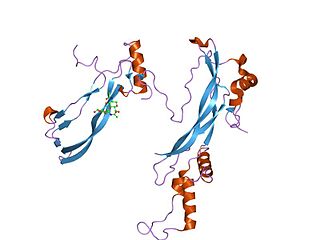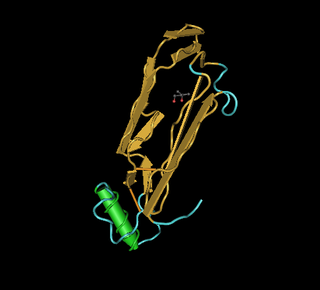Bone morphogenetic proteins (BMPs) are a group of growth factors also known as cytokines and as metabologens. Originally discovered by their ability to induce the formation of bone and cartilage, BMPs are now considered to constitute a group of pivotal morphogenetic signals, orchestrating tissue architecture throughout the body. The important functioning of BMP signals in physiology is emphasized by the multitude of roles for dysregulated BMP signalling in pathological processes. Cancerous disease often involves misregulation of the BMP signalling system. Absence of BMP signalling is, for instance, an important factor in the progression of colon cancer, and conversely, overactivation of BMP signalling following reflux-induced esophagitis provokes Barrett's esophagus and is thus instrumental in the development of esophageal adenocarcinoma.

Noggin, also known as NOG, is a protein that is involved in the development of many body tissues, including nerve tissue, muscles, and bones. In humans, noggin is encoded by the NOG gene. The amino acid sequence of human noggin is highly homologous to that of rat, mouse, and Xenopus.

Bone morphogenetic protein 7 or BMP7 is a protein that in humans is encoded by the BMP7 gene.

Bone morphogenetic protein 2 or BMP-2 belongs to the TGF-β superfamily of proteins.

Bone morphogenetic protein 4 is a protein that in humans is encoded by BMP4 gene. BMP4 is found on chromosome 14q22-q23.

Bone morphogenetic protein 10 (BMP10) is a protein that in humans is encoded by the BMP10 gene.

Bone morphogenetic protein 8B is a protein that in humans is encoded by the BMP8B gene.

Bone morphogenetic protein 6 is a protein that in humans is encoded by the BMP6 gene.

Bone morphogenetic protein 1, also known as BMP1, is a protein which in humans is encoded by the BMP1 gene. There are seven isoforms of the protein created by alternate splicing.

Bone morphogenetic protein 3, also known as osteogenin, is a protein in humans that is encoded by the BMP3 gene.
The transforming growth factor beta (TGFB) signaling pathway is involved in many cellular processes in both the adult organism and the developing embryo including cell growth, cell differentiation, cell migration, apoptosis, cellular homeostasis and other cellular functions. The TGFB signaling pathways are conserved. In spite of the wide range of cellular processes that the TGFβ signaling pathway regulates, the process is relatively simple. TGFβ superfamily ligands bind to a type II receptor, which recruits and phosphorylates a type I receptor. The type I receptor then phosphorylates receptor-regulated SMADs (R-SMADs) which can now bind the coSMAD SMAD4. R-SMAD/coSMAD complexes accumulate in the nucleus where they act as transcription factors and participate in the regulation of target gene expression.

Bone morphogenetic protein receptor type II or BMPR2 is a serine/threonine receptor kinase encoded by the BMPR2 gene. It binds bone morphogenetic proteins, members of the TGF beta superfamily of ligands, which are involved in paracrine signaling. BMPs are involved in a host of cellular functions including osteogenesis, cell growth and cell differentiation. Signaling in the BMP pathway begins with the binding of a BMP to the type II receptor. This causes the recruitment of a BMP type I receptor, which the type II receptor phosphorylates. The type I receptor phosphorylates an R-SMAD, a transcriptional regulator.

The bone morphogenetic protein receptor, type IA also known as BMPR1A is a protein which in humans is encoded by the BMPR1A gene. BMPR1A has also been designated as CD292.

Growth differentiation factor 2 (GDF2) also known as bone morphogenetic protein (BMP)-9 is a protein that in humans is encoded by the GDF2 gene. GDF2 belongs to the transforming growth factor beta superfamily.

Growth/differentiation factor 5 is a protein that in humans is encoded by the GDF5 gene.

Growth differentiation factor 6 (GDF6) is a protein that in humans is encoded by the GDF6 gene.

Growth differentiation factor 10 (GDF10) also known as bone morphogenetic protein 3B (BMP-3B) is a protein that in humans is encoded by the GDF10 gene.

Homeobox protein Hox-C8 is a protein that in humans is encoded by the HOXC8 gene.

Repulsive guidance molecule B (RGMb), also known as DRAGON, is a bone morphogenetic protein (BMP) co-receptor of the repulsive guidance molecule family. In humans this protein is encoded by the RGMB gene.

Chordin-like 1 is a protein that in humans is encoded by the CHRDL1 gene. Chordin-Like 1 (CHRDL1) is a structural glycoprotein that sits on the X chromosome and specifically encodes Venotropin, which is an antagonistic protein to bone morphogenic protein 4.






















